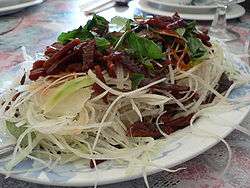Nepalese cuisine
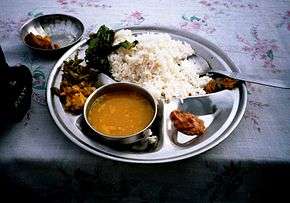
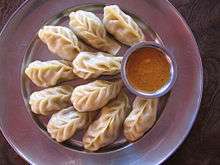
Nepalese cuisine refers to the food eaten in Nepal. Nepal's cultural and geographic diversity has resulted in a variety of cuisines based upon ethnicity and on soil and climate.
Dal-bhat-tarkari (Nepali: दाल भात तरकारी) is eaten throughout Nepal. Dal is a soup made of lentils and spices. This is served over boiled grain, bhat—usually rice but sometimes another grain—with vegetable curry, tarkari. Condiments are usually small amounts of extremely spicy chutney (चटनी) or pickle (achaar, अचार) which can be fresh or fermented. The variety of these is staggering, said to number in the thousands.[1] Other accompaniments may be sliced lemon (nibuwa) or lime (kagati) with fresh green chili (hariyo khursani). Dhindo (ढिंडो) is a traditional food of Nepal.
Much of the cuisine is variation on Asian themes. Other foods have hybrid Tibetan, Indian and Thai origins. Momo—Tibetan style dumplings with Nepalese spices—are one of the most popular foods in Nepal. They were originally filled with buffalo meat but now also with goat or chicken, as well as vegetarian preparations. Special foods such as sel roti and patre are eaten during festivals such as Tihar. New food varieties have been introduced such as taas,[2] similar to shish kebab.
Contact with Europeans has introduced loaf bread, cheese, pastries and ice cream, as well as restaurants serving dishes like pizza, catering originally to tourists but increasingly to local people too.
Types
Khas and Pahadi (generic Hill) cuisine
Dal-bhat-tarkari is the standard meal eaten twice daily. However, with land suitable for irrigated rice paddies in short supply, other grains supplement or even dominate. Wheat becomes unleavened flat bread (roti or chapati). Maize (makai), buckwheat (fapar), barley (jau), or millet (kodo) become porridge-like (dhido or ato). Tarkari can be spinach and fresh greens (sag), fermented and dried greens (gundruk or sinki), daikon radish (mula), potatoes (alu), green beans (simi), tomatoes (golbeda), cauliflower (kauli), cabbage (bandakopi), pumpkin (farsi), etc.

Fruit traditionally grown in the hills include mandarin orange (suntala), kaffir lime (kagati), lemon (nibuwa), Asian pear (nashpati), and bayberry (kaphal). Mangoes (aap) grow up to about 800 meters elevation.
Yogurt (dahi) and curried meat (masu) or fish (machha) are served as side dishes when available. Chicken (kukhura) and fish are usually acceptable to all but the Khas Brahmin (Bahun) caste, who are vegetarian. Observant Hindus never eat beef (gaiko masu). They also eschew buffalo and yak meat as being too cow-like. Domestic pork (sungurko masu) was traditionally only eaten by aadibasi, however wild boar (bangur ko masu) was traditionally hunted and eaten by magars. A strain derived from wild boar is now raised in captivity and used for meat that is increasingly popular with Pahari ethnicities and castes that did not traditionally eat pork.
Himalayan cuisine
Himalayan cuisine is influenced culturally by Tibetan and closely related ethnic groups in the Himalaya and Trans-Himalaya. Buckwheat, barley and millet are important cold-tolerant grains often processed into noodles or tsampa which is flour ground from toasted grain. Butter tea is made by mixing butter or ghee and salt into strong tea. This tea preparation is commonly mixed with tsampa flour to make a kind of fast food especially eaten while traveling.
Grain is also made into alcoholic beverages (see below). Potatoes are another important staple crop and food. Substantial amounts of rice are imported from the lowlands. The meat of yak and possibly yak-cow hybrids may be used, as well as their milk. Meat is often prepared as momo.

Thakali cuisine
Thakali cuisine—transitional between Himalayan and lowland cuisines—is eaten by Thakali people living in Thak-Khola Valley, an ancient and relatively easy trade route through the high Himalaya. This cuisine is also served in inns (bhattis) run by Thakalis alongside other trade routes and in Pokhara and other towns in the hills of central Nepal, that were said to offer the best food and accommodations before the great proliferation of facilities catering to foreign trekkers.
Thakali cuisine is less vegetarian than Pahari cuisine. Yak and yak-cow hybrids locally known as Jhopa were consumed by the lower castes. All castes eat the meat of local sheep called Bheda and Chyangra or Chiru imported from Tibet. Meat is sliced into thin slices and dried on thin poles near the cooking fire. Blood sausage is also prepared and dried. Dried meat is added to vegetable curries or sauteed in ghee and dipped into timur-ko-choup which is a mixture of red chili powder, Sichuan pepper, salt and local herbs. This spice mixture also seasons new potatoes, or eggs which may be boiled, fried or made into omelets.
Thakali cuisine uses locally grown buckwheat, barley, millet and dal, as well as rice, maize and dal imported from lower regions to the south. Grain may be ground and boiled into a thick porridge that is eaten in place of rice with dal. A kind of dal is even made from dried, ground buckwheat leaves. Grain can be roasted or popped in hot sand (which is then sieved off) as a snack food. Thakalis also follow the Tibetan customs of preparing tsampa and tea with butter and salt. Ghee is used in this tea preparation and as a cooking oil otherwise.
Since most Thakali people were engaged in trade, they could import vegetables, fruits and eggs from lower regions. A large variety of vegetables were consumed daily, some—especially daikon radish and beetroot—dried and often prepared with mutton. Soup prepared from spinach known as gyang-to was served with a pinch of timur-ko-choup. Apples were introduced following the arrival of foreign horticulturists[3] and are now widely enjoyed.
Newars


Newars are an urbanized ethnic group originally living in the Kathmandu Valley, but now also in bazaar towns elsewhere in the world Middle Hills. In the fertile Kathmandu and Pokhara valleys, local market farmers find growing produce more profitable than grain, especially now that cheap rice and other staples can be trucked in. Furthermore, Newar households have relatively high incomes and their culture emphasizes food and feasting.
Although daily Newar food practices consist mostly of components from the generic hill cuisine, during ritual, ceremonial and festive eating, Newar dishes can be much more varied than the generic Pahari ones. Newari cuisine makes wide use of buffalo meat. For vegetarians, meat or dried fish can be replaced by fried tofu or cottage cheese. The cuisine has a wide range of fermented preparations, whereas Pahari cuisine has beyond a few aachar condiments.
Kwāti (क्वाति soup of different beans), kachilā (कचिला spiced minced meat), chhoylā (छोयला water buffalo meat marinated in spices and grilled over the flames of dried wheat stalks), pukālā (पुकाला fried meat), wo (व: lentil cake), paun kwā (पाउँक्वा sour soup), swan pukā (स्वँपुका stuffed lungs), syen (स्येँ fried liver), mye (म्ये boiled and fried tongue), sapu mhichā (सःपू म्हिचा leaf tripe stuffed with bone marrow) and sanyā khunā (सन्या खुना jellied fish soup) are some of the popular festival foods.
Dessert consists of dhau (धौ yogurt), sisābusā (सिसाबुसा fruits) and mari (मरि sweets). There are achaars made with aamli fruit. Thwon (थ्वँ rice beer) and aylā (अयला local alcohol) are the common alcoholic liquors that Newars make at home.


Other ethnic variations in the Middle Hills
Buffalo meat and pork are eaten by many janajati (indigenous nationalities with customs departing from Hindu norms). More traditionally, Magars ate pork but not water buffalo while the superficially similar Gurung did the opposite. Further east, Tamang, Rai and Limbu have unique ethnic foods including kinema (fermented soybeans), yangben (Reindeer Moss), preparations of bamboo shoots, bread made from millet or buckwheat, and traditional Limbu drink tongba (millet beer).[4][5]
Terai cuisine
Food in the Terai south of Sivalik Hills refers to mirror cuisines such as Maithili cuisine[6] in the east, Tharu cuisine in the west, and Bhojpuri cuisine in the center and near west of Madhesh region of Nepal. Further west, there is Mughlai-influenced Awadhi cuisine—particularly eaten by the substantial Muslim population around Nepalganj.
Terai diets can be more varied than in the Middle Hills because of greater variety of crops grown locally plus cash crops imported from cooler microclimates in nearby hill regions, as well as from different parts of Greater Nepal. Fruit commonly grown in the Terai include mango (aap), litchi, papaya (armewa/mewa), banana (kera/kela) and jackfruit (katahar/katahal).
A typical terai set includes basmati rice with ghee, pigeon pea daal, tarkari(cooked variety of vegetable), taruwa ( a batter of raw vegetable such as potato,brinjal/aubergine, chilli, cauliflower etc. deep fried in the oil),papadum, mango/lemon pickles and youghurt. For non-veg items, they consume mostly fish or goat curry. Traditionally there never used to be a poultry items but nowadays due to urbanization poultry items are common too.
Nepal has seven low elevation Inner Terai valleys enclosed by the Sivalik and Mahabharat ranges. Historically these valleys were extremely malarial and populated mainly by the Tharu and Maithil people who had genetic resistance. Since the valleys were isolated from one another, different Tharu enclaves spoke different dialects and had different customs. They may have had different cuisines, although this has not been very well studied. Nevertheless, most Tharu historically obtained a varied diet through hunting and gathering as well as shifting agriculture and animal husbandry.
This contrasted with diets of Pahari Hindus that were predominantly agricultural and utilized only a few sources of animal protein because of religious or caste prohibitions. In the 1950s when Nepal opened its borders to foreigners and foreign aid missions, malaria suppression programs in the Inner Madhesh made it possible for people without genetic resistance to survive there, so the Tharu and Maithil faced an influx of people fleeing land and food deficits in the hills. Conversion of forest and grassland to cropland and prohibitions on hunting shifted the Tharu and Maithil in east and west away from land-based hunting and gathering, toward greater utilization of fish,[7] freshwater crab, prawns and snails from rivers and ponds.
Tharu also raise chickens and are reported to employ dogs to hunt rats in rice paddies and then roast them whole on sticks. Mutton may be obtained from nomadic hill people such as Kham Magar who take herds of sheep and goats up to sub-alpine pastures bordering the high Himalaya in summer, and down to Inner Madhesh valleys in winter. Increasing competition for land forces the Tharu and Maithil people away from shifting cultivation toward sedentary agriculture, so the national custom of eating rice with lentils gains headway. The Tharu or Maithil also have unique ways of preparing these staples, such as rice and lentil dumplings called bagiya or dhikri[8] and immature rice is used to make a kind of gruel maar.
Taro root is an important crop in the region. The leaves and roots are eaten. Sidhara[9] is a mixture of taro root, dried fish and turmeric that is formed into cakes and dried for preservation. The cakes are broken up and cooked with radish, chili, garlic and other spices to accompany boiled rice. Snails are cleansed, boiled and spiced to make ghonghi.[10] Another short compendium of Tharu and Maithil recipes[11] includes roasted crab, wheat flatbread fried in mustard oil, and fried taro leaf cakes.
Lohorung cuisine
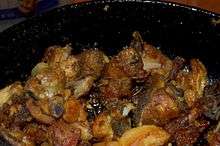
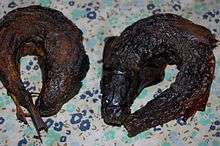
Lohorung are indigenous to eastern Nepal. They have a variety of food in their cuisine made from local ingredients. Some of them are Tongba, Wachipa, Wamik, Masikdaam, Kinima, Sibring, Sel roti, Bawari, Dhule Achar, Saruwa, Chamre, Yangpen, Dibu, and so on.
Snacks
Snacks include maize popped or parched called khaja (literally, "Eat and run."); beaten rice (baji or chiura), dry-roasted soybeans (bhatmas, Nepali: भटमास), dried fruit candy (lapsi), and South Asian foods like the samosa and South Asian sweets. International snacks like biscuits (packaged cookies), potato chips and wai wai (Nepali: वाइ वाइ, instant noodles) are all coming into widespread use. Whereas, some youths in Nepal prefer western snacks as they are easy to get and less time consuming.

Beverages
Tea (chiya) usually taken with milk and sugar, juice of sugarcane (sarbat), and buttermilk (mahi) are common non-alcoholic beverages. Alcoholic beverages include raksi, spirits made in rustic distilleries, and jard, homemade beer made from rice. At higher elevations there is millet beer (tongba or chhaang).
- Street vendor of snack foods
 Raksi distillery
Raksi distillery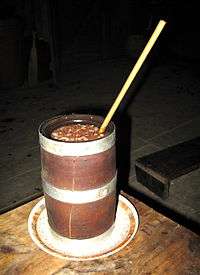 Millet beer
Millet beer
Etiquette
Meals are traditionally eaten seated or squatting on the floor although urban restaurants have tables and chairs. A large mound of bhat (boiled rice or other grains such as cornmeal or barley) or a pile of roti (rounds of thin unleavened bread) is served on a Jharke thal—a rimmed brass or stainless steel plate about 12"/30 cm. diameter. The rice is surrounded by smaller mounds of prepared vegetables, fresh chutney or preserved pickles, and sometimes curd/yoghurt, fish or meat.
Soup-like dal and vegetables cooked in sauce may be served in separate small bowls, to be poured over the rice. Food is brought to the mouth with the fingers of the right hand. The left hand—traditionally used for certain toilet purposes—should never touch food but may hold cups and glasses. The right hand should be rinsed before and after eating.
Although Nepalese society is moving away from caste-based discrimination and becoming less mindful of ritual pollution, these concepts can still hold sway in traditionally minded upper caste households. In such contexts water itself is highly subject to pollution, affecting containers as well. Clay or wooden containers must then be discarded while metal containers require ritual scouring. You will often find people drinking water by pouring it into their mouths rather than touching their lips to the container to avoid polluting the container and contents.
Dry-cooked grains—including beaten rice and roasted soybeans or corn—and rice pudding cooked in milk rather than water (khir), as well as raw fruit are less subject to ritual pollution. These foods can be accepted from any clean caste but not from the Dalit. However water and foods cooked with water can be problematic. Traditionally they are not to be cooked or touched by a person of lower caste than the recipient. For this reason even in a polygamous household the first wife should not be of lower caste than the husband.
Foreigners and members of many partially Hinduized janajati ethnic groups may occupy an ambiguous space, neither fully untouchable nor fully "clean". They may not be welcome inside upper-caste homes and should not presume to enter without being invited (and not just invited to sit outside on the porch). Upper-caste Hindus may decline to eat with them at all, or may avoid eating foods that most subject to ritual pollution.
Breaches of dietary etiquette were made criminal offences in Muluki Ain—the main corpus of civil law—in 1854 and not decriminalized until 1962. Since 1962 discriminatory customs have been falling into disuse among educated and urban Nepalese, yet they often prevail in the countryside. Guests and visitors should try to conform to tradition until clearly instructed otherwise by their hosts.
See also
References
- ↑ "Pickle - Achar - Chutney". Food-nepal.com. Retrieved 12 September 2010.
- ↑ http://www.nepalitimes.com/issue/2012/08/10/Review/19536
- ↑ Lok Nath Devkota. "Deciduous Fruit in Nepal". FAO. Retrieved 14 October 2013.
- ↑ "?About Historical and Contemporary Limbu Women of Nepal?". Forum.welovenepal.com. 24 June 2008. Retrieved 12 September 2010.
- ↑ "The Sikkim cuisines". Indiatraveltimes.com. Retrieved 12 September 2010.
- ↑ "Nepali Mithila Cuisine". Mithilacuisine.blogspot.com. Retrieved 12 September 2010.
- ↑ VOICE OF THARUS: Fishing and the Tharus including Maithil
- ↑ VOICE OF THARUS: Bagiya – the rice flour dumplings made the Tharu way
- ↑ VOICE OF THARUS: Sidhara – the colocasia concoction
- ↑ VOICE OF THARUS: Excuse me, it’s escargot!
- ↑ VOICE OF THARUS: Three mouth-watering Tharu dishes
Further reading
- Löwdin, Per (2002) [1986]. "Food, Ritual and Society: A Study of Social Structure and Food Symbolism among the Newars" (Ph.D. dissertation, Department of Culture Anthropology, University of Uppsala, Sweden). Retrieved 17 November 2013.
External links
- Guide to Nepali food
- Saidi, Nicole. "In search of Nepal's culinary identity." CNN. 14 October 2011.
- Nepali food recipes
- Nepali food
- Authentic Nepali food

